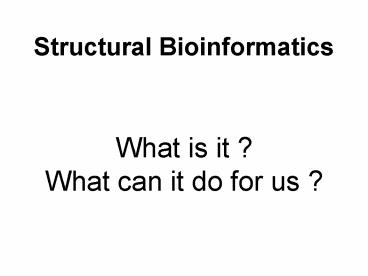Structural Bioinformatics - PowerPoint PPT Presentation
1 / 58
Title:
Structural Bioinformatics
Description:
Structural Bioinformatics. What is it ? What can it do for us ? Genomics ... Structural Bioinformatics. What does it do? If there is an experimental structure ... – PowerPoint PPT presentation
Number of Views:370
Avg rating:3.0/5.0
Title: Structural Bioinformatics
1
Structural Bioinformatics
What is it ? What can it do for us ?
2
Genomics
Sequence Data
3
Genomics
Detection Monitoring of Diseases
Sequence Data
- Cancer
- Genetic abnormalities
- Alzheimers
4
Genomics
Detection Monitoring of Diseases
Sequence Data
- Cancer
- Genetic abnormalities
- Alzheimers
Species comparisons
Understanding Evolution/Taxonomy
5
Sequence
Expression
Structure
Interactions
Function
6
What can I do with a structure?
- Deduce function
- Identify drug targets
- Compare across species
7
How to determine the structure?
- X-Ray Crystallography
- NMR Spectroscopy
- Homology Modelling
8
Xray Crystallography(Advantages Disadvantages)
- Detailed information
- Extremely accurate
- Works for all sizes of molecules
- Requires large amounts of very pure material
(10-100mg) - Obtaining crystals is more an art than science
- Can be slow and labour intensive.
9
NMR Spectroscopy(Advantages Disadvantages)
- "Solution" view of the molecule.
- Dynamic information.
- Does not require any pretreatment
- Stability at high temperature (37oC) for extended
periods. - Requires fairly large amounts of pure material.
- Does not work for very large molecules.
10
Homology Modelling
- Simple, fast.
- Does not require any physical material
- Requires accurate (experimental) structure of one
or more homologous protein(s). - Low accuracy unless sequence homology is
extremely high.
11
Overview of Protein Structure
H2N-C-CONH-C-CONH-C-COOH
R
R
R
12
Overview of Protein Structure
H2N-C-CONH-C-CONH-C-COOH
R
R
R
13
Overview of Protein Structure
H2N-C-CONH-C-CONH-C-COOH
R
R
R
14
(No Transcript)
15
(No Transcript)
16
(No Transcript)
17
(No Transcript)
18
(No Transcript)
19
(No Transcript)
20
(No Transcript)
21
(No Transcript)
22
(No Transcript)
23
(No Transcript)
24
(No Transcript)
25
(No Transcript)
26
(No Transcript)
27
(No Transcript)
28
(No Transcript)
29
(No Transcript)
30
(No Transcript)
31
(No Transcript)
32
(No Transcript)
33
(No Transcript)
34
(No Transcript)
35
(No Transcript)
36
(No Transcript)
37
(No Transcript)
38
(No Transcript)
39
(No Transcript)
40
(No Transcript)
41
3D Structure Comparison
- Dejavu (Uppsala)
- DALI (EMBL)
- VAST (NIH)
Databases
CATH
SCOP
42
Forces that build up a molecule
Quantum Mechanical Empirical Force
Field Knowledge Based Potentials
43
(No Transcript)
44
(No Transcript)
45
Homology Modelling
- Place sequence on template structure
- Adjust sidechain positions according to rotamers
- Build loops
- Refine using PEF
- Validate using Ramachandran plots.
46
Docking ligands into proteins
47
Docking ligands into proteins
48
(No Transcript)
49
(No Transcript)
50
(No Transcript)
51
(No Transcript)
52
(No Transcript)
53
(No Transcript)
54
(No Transcript)
55
(No Transcript)
56
Structural Bioinformatics
What does it do?
57
If there is an experimental structure
- Compare structure with other known structures.
- Detailed analysis at a non-intuitive level.
- Generate hypotheses for further experimentation.
58
If there is no experimental structure
- Generate a plausible model.
- Identify potential interactions.
- Identify probable Dead Ends and save the
experimentalist some nightmares.































